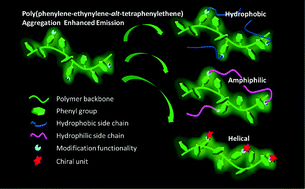Poly(phenylene-ethynylene-alt-tetraphenylethene) copolymers: aggregation enhanced emission, induced circular dichroism, tunable surface wettability and sensitive explosive detection†
Abstract
A conjugated alternative copolymer (P0), containing tetraphenylethylene (TPE) and phenylene-ethynylene (PE) units, was prepared by the Sonogashira coupling polymerization with high yield (96.8%). With the aid of activated ester on the PE unit, differently functionalized copolymers (P1 and P2) were derived from P0, and their structures were well characterized using multiple spectroscopic methods. Due to the incorporation of TPE units into the polymer structure, all of these copolymers (P0, P1 and P2) showed aggregation enhanced emission (AEE) properties as revealed by the fluorescence behaviors observed in THF/water and THF/hexane mixtures. As AEE-active polymers, they were investigated for use as fluorescent probes for explosive detection. Using picric acid (PA) as a model explosive, the Stern–Volmer curves showed a super-amplification effect for all these copolymers, and the largest fluorescence quenching constant (kSV) was calculated to be 56 100 M−1 for P1 in THF/water mixture with 90% water fraction. This value is comparable to that reported for TPE-containing hyperbranched polymers. By the reaction of the chiral primary amine with P0, the chiral dichroism (CD) signal was recorded for the derived copolymer P1 and the evident Cotton effect shifted to around 380 nm, indicating that the chirality was transferred from the side chain to the main chain. By the substitution of the hydrophobic activated ester with the highly hydrophilic poly(ethylene glycol) (PEG1000), the obtained copolymer P2 could be molecularly dispersed in water and gave a clear aqueous solution. The film casting from the P2 THF solution displayed a moderate hydrophilic surface static contact angle of 66.8°, which varied to 33.6° after immersion in THF/water mixture (1 : 1 by volume) for hours, and the microstructural morphology underwent a change from coarse spheres to microfibers, as suggested by scanning electron microscope (SEM) images.



 Please wait while we load your content...
Please wait while we load your content...